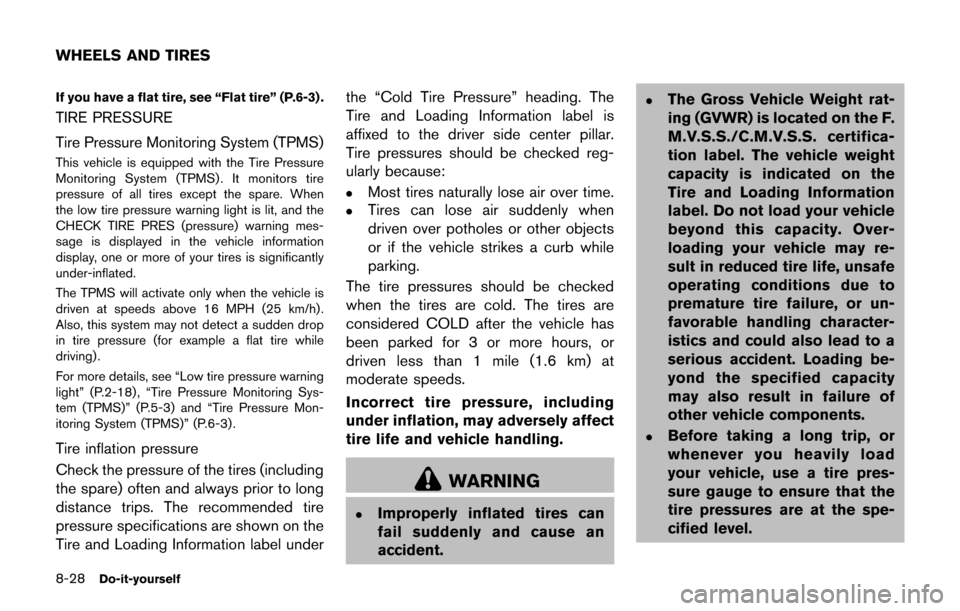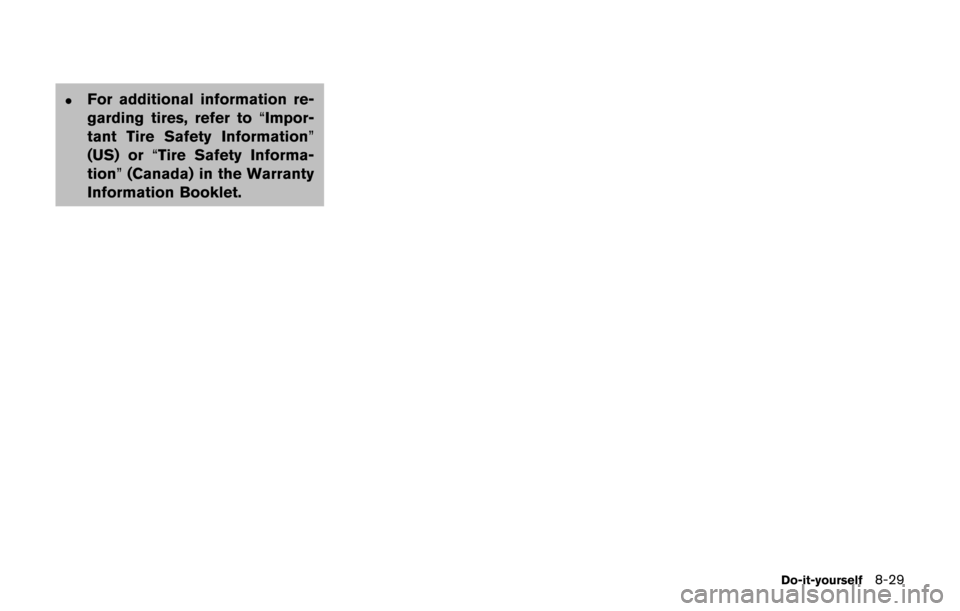NISSAN JUKE 2017 F15 / 1.G Owners Manual
Manufacturer: NISSAN, Model Year: 2017, Model line: JUKE, Model: NISSAN JUKE 2017 F15 / 1.GPages: 416, PDF Size: 2.62 MB
Page 351 of 416

8-26Do-it-yourself
EXTERIOR AND INTERIOR LIGHTS
ItemWattage (W)Bulb No.
Headlight high/low beams (Xenon)* 60/35HB3/D2S
Headlight high/low beams (Halogen) 60/55HB3/H11
Front turn signal light* 21WY21W
Front parking light* LED-
Front side marker light* 5W5W
Front fog light (if so equipped)* 55H11
Side turn signal light* LED-
Daytime running light (for NISMO models)* LED-
Rear combination light*
turn signal light 21WY21W
stop/tail light 21/5W21/5W
tail light (LED) LED—
back-up 16W16W
License plate light* 5W5W
Map light 5—
High-mounted stop light* LED—
Cargo light 5—
Glove box light* 1.4—
*: It is recommended you visit a NISSAN dealer for replacement.
NOTE: Always check with the Parts Department at a NISSAN dealer for the latest information about parts.
Page 352 of 416

SDI2306
: REMOVE
: INSTALL
Replacement procedures
All other lights are either type A, B, C, D or E.
When replacing a bulb, first remove the lens
and/or cover.
SDI2391
Map light
SDI2653Cargo light
Do-it-yourself8-27
Page 353 of 416

8-28Do-it-yourself
If you have a flat tire, see “Flat tire” (P.6-3) .
TIRE PRESSURE
Tire Pressure Monitoring System (TPMS)
This vehicle is equipped with the Tire Pressure
Monitoring System (TPMS) . It monitors tire
pressure of all tires except the spare. When
the low tire pressure warning light is lit, and the
CHECK TIRE PRES (pressure) warning mes-
sage is displayed in the vehicle information
display, one or more of your tires is significantly
under-inflated.
The TPMS will activate only when the vehicle is
driven at speeds above 16 MPH (25 km/h) .
Also, this system may not detect a sudden drop
in tire pressure (for example a flat tire while
driving) .
For more details, see “Low tire pressure warning
light” (P.2-18) , “Tire Pressure Monitoring Sys-
tem (TPMS)” (P.5-3) and “Tire Pressure Mon-
itoring System (TPMS)” (P.6-3) .
Tire inflation pressure
Check the pressure of the tires (including
the spare) often and always prior to long
distance trips. The recommended tire
pressure specifications are shown on the
Tire and Loading Information label underthe “Cold Tire Pressure” heading. The
Tire and Loading Information label is
affixed to the driver side center pillar.
Tire pressures should be checked reg-
ularly because:
.Most tires naturally lose air over time.
.Tires can lose air suddenly when
driven over potholes or other objects
or if the vehicle strikes a curb while
parking.
The tire pressures should be checked
when the tires are cold. The tires are
considered COLD after the vehicle has
been parked for 3 or more hours, or
driven less than 1 mile (1.6 km) at
moderate speeds.
Incorrect tire pressure, including
under inflation, may adversely affect
tire life and vehicle handling.
WARNING
.Improperly inflated tires can
fail suddenly and cause an
accident.
.The Gross Vehicle Weight rat-
ing (GVWR) is located on the F.
M.V.S.S./C.M.V.S.S. certifica-
tion label. The vehicle weight
capacity is indicated on the
Tire and Loading Information
label. Do not load your vehicle
beyond this capacity. Over-
loading your vehicle may re-
sult in reduced tire life, unsafe
operating conditions due to
premature tire failure, or un-
favorable handling character-
istics and could also lead to a
serious accident. Loading be-
yond the specified capacity
may also result in failure of
other vehicle components.
.Before taking a long trip, or
whenever you heavily load
your vehicle, use a tire pres-
sure gauge to ensure that the
tire pressures are at the spe-
cified level.
WHEELS AND TIRES
Page 354 of 416

.For additional information re-
garding tires, refer to“Impor-
tant Tire Safety Information”
(US) or “Tire Safety Informa-
tion” (Canada) in the Warranty
Information Booklet.
Do-it-yourself8-29
Page 355 of 416

8-30Do-it-yourself
SDI2503
Tire and Loading Information label
*1Seating capacity: The maximum
number of occupants that can be
seated in the vehicle.
*2Vehicle load limit: See “Vehicle
loading information” (P.10-15) .
*3Original size: The size of the tires
originally installed on the vehicle at
the factory.
*4Cold tire pressure: Inflate the tires to
this pressure when the tires are
cold. Tires are considered COLDafter the vehicle has been parked for
3 or more hours, or driven less than
1 mile (1.6 km) at moderate speeds.
The recommended cold tire inflation
is set by the manufacturer to provide
the best balance of tire wear, vehicle
handling, driveability, tire noise, etc.,
up to the vehicle’s GVWR.
*5Tire size — see “Tire labeling” (P.8-
34) .
*6Spare tire size or compact spare tire
size (if so equipped)
Page 356 of 416

SDI1949
Checking the tire pressure
1. Remove the valve stem cap from thetire.
2.Press the pressure gauge squarely
onto the valve stem. Do not press too
hard or force the valve stem side-
ways, or air will escape. If the hissing
sound of air escaping from the tire is
heard while checking the pressure,
reposition the gauge to eliminate this
leakage.
3.Remove the gauge.
4.Read the tire pressure on the gauge
stem and compare it to the specifica-
tion shown on the Tire and Loading
Information label.
5.Add air to the tire as needed. If too
much air is added, press the core of
the valve stem briefly with the tip of
the gauge stem to release pressure.
Recheck the pressure and add or
release air as needed.
6.Install the valve stem cap.
7.Check the pressure of all other tires,
including the spare.
Do-it-yourself8-31
Page 357 of 416

8-32Do-it-yourself
Except for NISMO and NISMO RS models:
SIZECOLD TIRE INFLATION
PRESSURE
FRONT ORIGINAL TIRE P215/55R17 93V 230 kPa, 33 PSI (2WD
MT models)
250 kPa, 36 PSI (2WD
CVT models)
240 kPa, 35 PSI (AWD
models)
REAR ORIGINAL TIRE P215/55R17 93V 230 kPa, 33 PSI (2WD
MT models)
250 kPa, 36 PSI (2WD
CVT models)
240 kPa, 35 PSI (AWD
models)
SPARE TIRE T135/80D16 101M (2WD
models)
T135/90D16 102M (AWD
models) 420 kPa, 60 PSI
Page 358 of 416

For NISMO models:
SIZECOLD TIRE INFLATION
PRESSURE
FRONT ORIGINAL TIRE 225/45R18 95Y 230 kPa, 33 PSI (2WD
MT models)
240 kPa, 35 PSI (AWD
models)
REAR ORIGINAL TIRE 225/45R18 95Y 230 kPa, 33 PSI (2WD
MT models)
240 kPa, 35 PSI (AWD
models)
SPARE TIRE T135/80D16 101M (2WD
models)
T135/90D16 102M (AWD
models) 420 kPa, 60 PSI
Do-it-yourself8-33
Page 359 of 416

8-34Do-it-yourself
For NISMO RS models:
SIZECOLD TIRE INFLATION
PRESSURE
FRONT ORIGINAL TIRE 225/45R18 95Y 230 kPa, 33 PSI (2WD
MT models)
240 kPa, 35 PSI (AWD
models)
REAR ORIGINAL TIRE 225/45R18 95Y 230 kPa, 33 PSI (2WD
MT models)
240 kPa, 35 PSI (AWD
models)
SPARE TIRE T135/70D17 92M 420 kPa, 60 PSI
SDI1575
Example
TIRE LABELING
Federal law requires tire manufacturers
to place standardized information on the
sidewall of all tires. This information
identifies and describes the fundamental
characteristics of the tire and also
provides the tire identification number
(TIN) for safety standard certification.
The TIN can be used to identify the tire
in case of a recall.
Page 360 of 416

SDI1606
Example
*1Tire size (example: P215/60R16
94H)
1. P: The “P” indicates the tire is designed for passenger vehicles.
(Not all tires have this information.)
2. Three-digit number (215): This num- ber gives the width in millimeters of
the tire from sidewall edge to sidewall
edge.
3. Two-digit number (60): This number, known as the aspect ratio, gives the
tire’s ratio of height to width. 4. R: The “R” stands for radial.
5. Two-digit number (16): This number
is the wheel or rim diameter in inches.
6. Two- or three-digit number (94): This number is the tire’s load index. It is a
measurement of how much weight
each tire can support. You may not
find this information on all tires
because it is not required by law.
7. H: Tire speed rating. You should not drive the vehicle faster than the tire
speed rating.
JVM0694X
Example
*2TIN (Tire Identification Number) for a
new tire (example: DOT XX XX XXX
XXXX)
1. DOT: Abbreviation for the “Depart- ment of Transportation”. The symbol
can be placed above, below or to the
left or right of the Tire Identification
Number.
2. Two-digit code: Manufacturer’s iden- tification mark
3. Two-digit code: Tire size
Do-it-yourself8-35